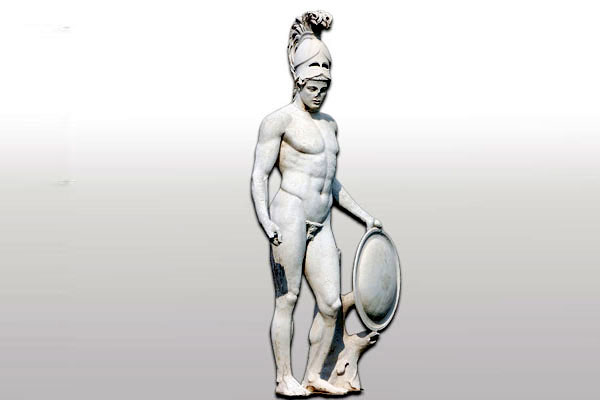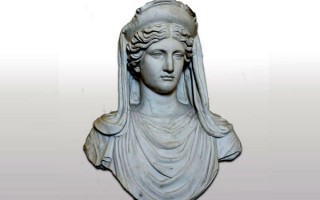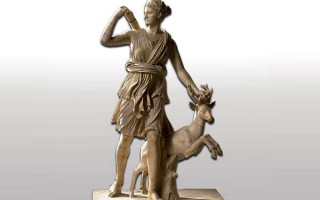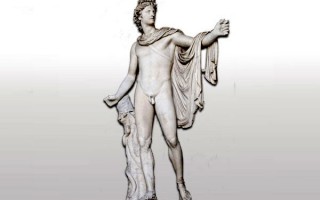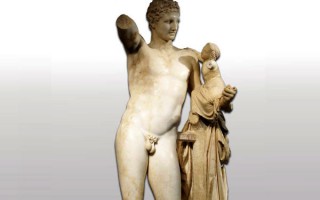Ares is the Greek god of war. He’s one of the Twelve Olympians, and the son of Zeus and Hera. In myths, Mars appears bellicose and provocative and represents the impulsive nature of the war.
Thanks to his son Oenomaos from Steropi, Mars became ancestor of renowned people, such as of Atreus, Thyestes, Agamemnon, Menelaus, Aegisthus, Orestes, Electra, Pylades, Pittheus, Theseus, Hippolytus , Iphigenia, Demophon, Akamas, Eurystheus, Amphitryon, Alcmene, Iolaus, Hercules, Admetus, Kopreus, Alkathoos and Ajax of Telamon.
Ares usually appears in battle on foot, breaking the momentum of chariots and demolishing the walls. Other times he is on a chariot with two (Deimos and Phobos), or four magnificent horses (sons of Boreas and Fury) (Phobos, Aithonas, Flogios and Konavos, as Quintus Smyrnaeus calls them).
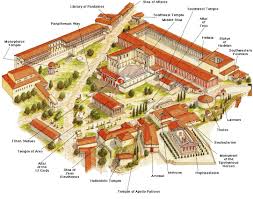 The Temple of Ares, which was excavated in 1937, is one of the four important monuments transferred to the Athenian Agora during the years of Emperor Augustus. It is a typical temple structure of the peak of Athenian 5th century. B.C. architecture. It was moved probably from Mesogeia area, and not from Acharnes, as previously thought. Today it survives in a very poor condition.
The Temple of Ares, which was excavated in 1937, is one of the four important monuments transferred to the Athenian Agora during the years of Emperor Augustus. It is a typical temple structure of the peak of Athenian 5th century. B.C. architecture. It was moved probably from Mesogeia area, and not from Acharnes, as previously thought. Today it survives in a very poor condition.The central triangular space formed between the Middle Stoa, the Panathenaic Way and the road that runs along the east side of the Agora, with buildings dedicated to the worship of the gods and the city administration, acquired new use after the founding of the Roman Agora, during the reign of Augustus. So the space was filled mostly with religious buildings, transferred from other sites (Temple of Ares, Zeus Altar Agoraios, S.E. temple, S.W. temple) and the bulky Odeon of Agrippa.
The Temple of Mars is mentioned by Pausanias (1.8.4), but he did not know that the monument was moved there from elsewhere. This became clear when the site was excavated in 1937. Some architectural fragments, which belonged to the temple, had already been discovered in 1931, when the excavation of the Agora begun.
Only a part of the foundation of the temple survives, at the eastern end of stereobate. It consists of limestone in second use, placed on a layer of crushed stones. The shape of the building, is revealed by the excavation as indicated by the incision made in the rock, during its placement.
The temple was cut to pieces and transported as such in the Agora of Athens during Augustus’ reign. Previously was thought to have been transferred from the town of Acharnes, where sources report an important temple and worship of Mars in general. However, recent research has shown that this is not true. More probable today seems Manolis Korres view, who claims the temple to have been moved there from Mesogeia, namely Pallini (where it was originally dedicated to Athena). Other opinions (that the temple stood somewhere in the asty [city] or even the market) are completely unfounded. Obviously, the transfer of the temple and its dedication on Mars, are associated with the cult of the imperial family: Augustus grandson Gaius, who was extremely popular in the East, was worshiped in Greece by the nickname “New Mars”, as evidenced by inscription 2 AD, possibly associated with the re-dedication of the temple (IG II² 3250). This identification undoubtedly gave impetus to the cult of Mars on the eastern Roman Empire, along with the fact that one of the deities August especially promoted in Rome itself was Mars Ultor.
The view of transfer is based on the fact that in many of the 200 surviving architectural parts of the superstructure (which is recognizable thanks to its characteristic pentelic marble with veins of gray-greenish chlorite) that were found over a wide area in the Agora, engraved tectonic marks have been preserved, that guided the builders of the Roman period for the position they had to be placed during the reassembly of the temple (e.g. AP = left, O = opisthodomos, B = second tier of stereobate, E = efthyntiria etc. .).
Of the four surviving column drums, one was found near the temple, the second at the southwest end of the Agora (now incorporated in the restored northern column of the portico of Hephaestus temple), while two others were later used as millstones. Members from every part of the temple were also found (triglyphs, capitals, architrave, marble tiles, etc.), which clearly show both the layout and the style of the temple.
The drainpipe of Poseidon’s temple in Sounion was found in the same area. It seems that it was moved here in order to be placed in the temple of Mars.
The temple is a typical sample of Athenian architecture, of the third quarter of the 5th century BC. According to Dinsmoor, it is one of the four surviving works of the so called “Architect of the Hephaisteion”, and even the third one chronologically dated in the period from 436 to 432 BC, in the middle of Pericles program. The other three temples are, in order of erection and always according to Dinsmoor, the Hephaisteion (449-444 BC), the temple of Poseidon in Sounion and even later, the temple of Nemesis at Rhamnus (432 BC). As for the design and execution of construction, the temple of Mars is the one closest to the Hephaisteion.
It is a hexastyle Doric temple, double in antis, with narthex, nave and opisthodomos. Its dimensions are: stereobate 17 × 0, 36 m., 15., 88 × 34,71 m. at the stylobate and at the height of the Doric frieze 14,51 × 34,04 m. It had 13 columns on the long side, according to the model of Doric buildings of the era. The height of the columns has been estimated at 6.02 to 6.20 m. The axis space between the columns was defined from 2.68 to 2.69 m., except on the corner, which is estimated at 2.48 to 2.49 m. Although the lower part of the pediments was reinforced in order to place sculptures, there is no indication of sculptural relief decoration on the preserved fragments. A fragmentary marble sculpture, whose parts were discovered during the excavation of the trench for the electric railway in 1891, as well as during excavations in 1951, may have belonged to the temple as a finial. It is a wingless female figure moving towards the viewer.
The Temple of Mars was destroyed in 267 AD during the raid of the Herulians in Athens. Significant parts of the superstructure, out of Pentelic marble, were walled in the roman walls. The destruction was not complete however, as it was partly incorporated into the Late Roman Villa or Gymnasium in the 5th century. A.D.
The foundations of the Altar of Mars, located about 10 m. in front of the facade of the temple, is the only surviving part from the monument. The dimensions of the foundation is 6, 30 × 8, 90 m. It consists of reused limestone. In the eastern part of the foundation stood the altar, while on the west there was a staircase. The architectural parts preserved testify that the altar, which was also moved to its final location at the same time as the temple, dated to the second half of 4th century. B.C.
 In a flat area near the present village Hellinika, between Agios Nikolaos and Elounda, in the border area of the ancient city-states Lato and Olous, there was a very old sanctuary dedicated to Aphrodite, the “Ancient Aphrodision” as mentioned in inscriptions of the 2nd c. B.C. The place took on new significance when conflicts between the two cities on border disputes escalated and approximately in the position of the dilapidated one-room geometrical temple, in 2nd century. B.C. the temple for two synnaoi deities [worshipped in the same temple], Mars and Venus was erected. The rectangular geometric era temple, measuring 4 x 9 m. was oriented to the west. In front of the facade was the trapezoidal altar, which probably was the center of a vestibule with five columns. According to the excavators the building was not used after the Geometric period and possibly at the end of the 2nd century. B.C. was already in ruins. To the west of the geometric period altar, the newer two-aisled temple was founded by the city of Lato, oriented to the east, with common nave for the two aisles, which was built later on top of the geometric period altar. For each of the houses there was separate entrance door from the common vestibule. The stone lintel of the eastern door of the south aisle, dedicated to Mars, is preserved, as seen from a discovered inscription that refers to construction work in the temple of Mars, and there was another access to it from the south wall of the building. From the inscriptions, the progress of construction projects and subsequent additions and repairs of the later temple are made obvious as well as the development of border disputes which were resolved, since assistance was required through arbitrations and setting of borderlines, by the Knossians, Romans and Miletians. The arbitrations and related conditions should also be placed in the “Dera sanctuary” or the temple of Mars in Dera area -and indeed many of them were found in the sanctuary of Lenika. Eventually the sanctuary and the region were attributed to Lato.
In a flat area near the present village Hellinika, between Agios Nikolaos and Elounda, in the border area of the ancient city-states Lato and Olous, there was a very old sanctuary dedicated to Aphrodite, the “Ancient Aphrodision” as mentioned in inscriptions of the 2nd c. B.C. The place took on new significance when conflicts between the two cities on border disputes escalated and approximately in the position of the dilapidated one-room geometrical temple, in 2nd century. B.C. the temple for two synnaoi deities [worshipped in the same temple], Mars and Venus was erected. The rectangular geometric era temple, measuring 4 x 9 m. was oriented to the west. In front of the facade was the trapezoidal altar, which probably was the center of a vestibule with five columns. According to the excavators the building was not used after the Geometric period and possibly at the end of the 2nd century. B.C. was already in ruins. To the west of the geometric period altar, the newer two-aisled temple was founded by the city of Lato, oriented to the east, with common nave for the two aisles, which was built later on top of the geometric period altar. For each of the houses there was separate entrance door from the common vestibule. The stone lintel of the eastern door of the south aisle, dedicated to Mars, is preserved, as seen from a discovered inscription that refers to construction work in the temple of Mars, and there was another access to it from the south wall of the building. From the inscriptions, the progress of construction projects and subsequent additions and repairs of the later temple are made obvious as well as the development of border disputes which were resolved, since assistance was required through arbitrations and setting of borderlines, by the Knossians, Romans and Miletians. The arbitrations and related conditions should also be placed in the “Dera sanctuary” or the temple of Mars in Dera area -and indeed many of them were found in the sanctuary of Lenika. Eventually the sanctuary and the region were attributed to Lato.
